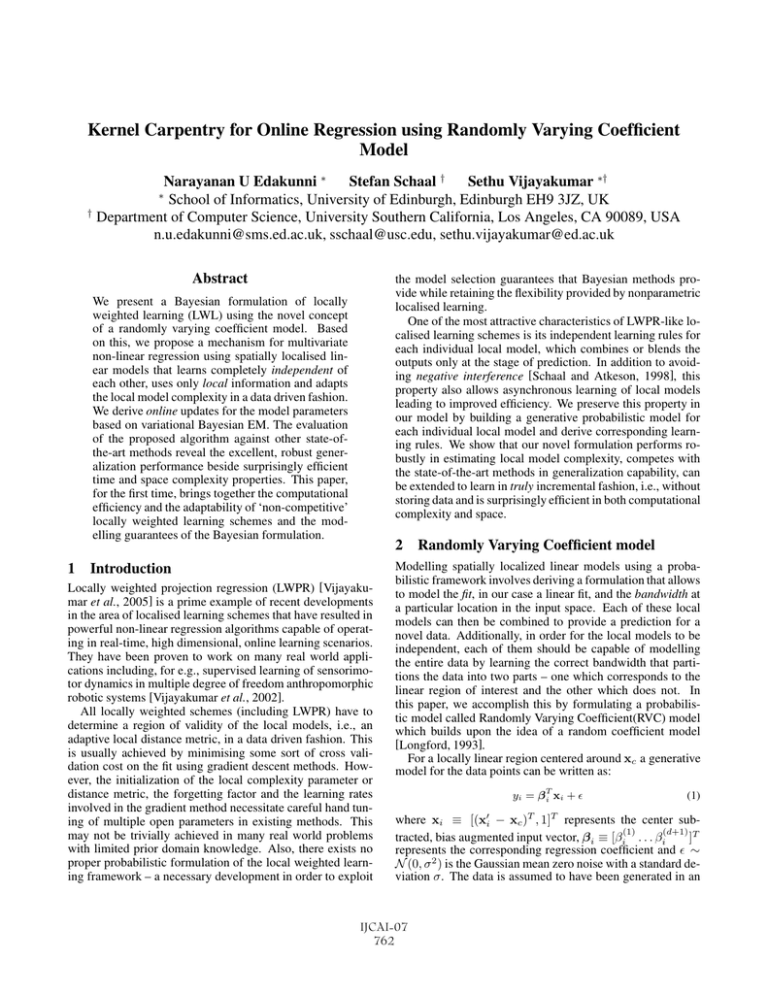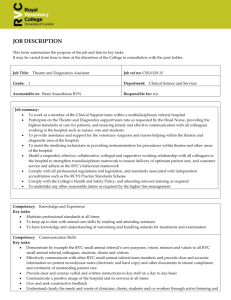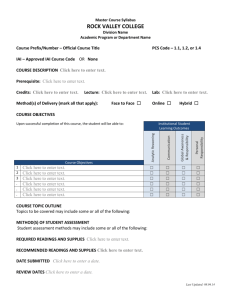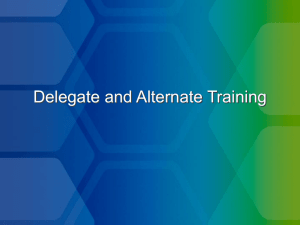Kernel Carpentry for Online Regression using Randomly Varying Coefficient Model
advertisement

Kernel Carpentry for Online Regression using Randomly Varying Coefficient
Model
Narayanan U Edakunni ∗
Stefan Schaal †
Sethu Vijayakumar ∗†
School of Informatics, University of Edinburgh, Edinburgh EH9 3JZ, UK
†
Department of Computer Science, University Southern California, Los Angeles, CA 90089, USA
n.u.edakunni@sms.ed.ac.uk, sschaal@usc.edu, sethu.vijayakumar@ed.ac.uk
∗
Abstract
the model selection guarantees that Bayesian methods provide while retaining the flexibility provided by nonparametric
localised learning.
One of the most attractive characteristics of LWPR-like localised learning schemes is its independent learning rules for
each individual local model, which combines or blends the
outputs only at the stage of prediction. In addition to avoiding negative interference [Schaal and Atkeson, 1998], this
property also allows asynchronous learning of local models
leading to improved efficiency. We preserve this property in
our model by building a generative probabilistic model for
each individual local model and derive corresponding learning rules. We show that our novel formulation performs robustly in estimating local model complexity, competes with
the state-of-the-art methods in generalization capability, can
be extended to learn in truly incremental fashion, i.e., without
storing data and is surprisingly efficient in both computational
complexity and space.
We present a Bayesian formulation of locally
weighted learning (LWL) using the novel concept
of a randomly varying coefficient model. Based
on this, we propose a mechanism for multivariate
non-linear regression using spatially localised linear models that learns completely independent of
each other, uses only local information and adapts
the local model complexity in a data driven fashion.
We derive online updates for the model parameters
based on variational Bayesian EM. The evaluation
of the proposed algorithm against other state-ofthe-art methods reveal the excellent, robust generalization performance beside surprisingly efficient
time and space complexity properties. This paper,
for the first time, brings together the computational
efficiency and the adaptability of ‘non-competitive’
locally weighted learning schemes and the modelling guarantees of the Bayesian formulation.
2 Randomly Varying Coefficient model
1 Introduction
Locally weighted projection regression (LWPR) [Vijayakumar et al., 2005] is a prime example of recent developments
in the area of localised learning schemes that have resulted in
powerful non-linear regression algorithms capable of operating in real-time, high dimensional, online learning scenarios.
They have been proven to work on many real world applications including, for e.g., supervised learning of sensorimotor dynamics in multiple degree of freedom anthropomorphic
robotic systems [Vijayakumar et al., 2002].
All locally weighted schemes (including LWPR) have to
determine a region of validity of the local models, i.e., an
adaptive local distance metric, in a data driven fashion. This
is usually achieved by minimising some sort of cross validation cost on the fit using gradient descent methods. However, the initialization of the local complexity parameter or
distance metric, the forgetting factor and the learning rates
involved in the gradient method necessitate careful hand tuning of multiple open parameters in existing methods. This
may not be trivially achieved in many real world problems
with limited prior domain knowledge. Also, there exists no
proper probabilistic formulation of the local weighted learning framework – a necessary development in order to exploit
Modelling spatially localized linear models using a probabilistic framework involves deriving a formulation that allows
to model the fit, in our case a linear fit, and the bandwidth at
a particular location in the input space. Each of these local
models can then be combined to provide a prediction for a
novel data. Additionally, in order for the local models to be
independent, each of them should be capable of modelling
the entire data by learning the correct bandwidth that partitions the data into two parts – one which corresponds to the
linear region of interest and the other which does not. In
this paper, we accomplish this by formulating a probabilistic model called Randomly Varying Coefficient(RVC) model
which builds upon the idea of a random coefficient model
[Longford, 1993].
For a locally linear region centered around xc a generative
model for the data points can be written as:
yi = β Ti xi + (1)
where xi ≡ [(xi − xc )T , 1]T represents the center sub(1)
(d+1) T
tracted, bias augmented input vector, βi ≡ [βi . . . βi
]
represents the corresponding regression coefficient and ∼
N (0, σ 2 ) is the Gaussian mean zero noise with a standard deviation σ. The data is assumed to have been generated in an
IJCAI-07
762
Region of locality
b
a
higher confidence over larger regions of the data. Therefore,
we use a Gamma regularizer prior over the bandwidth parameters such that it favors relatively small values of hj leading
to more localised models:
c
h2j ∼ Gamma(aj , bj )
(4)
We shall further assign noninformative Normal prior
N (μ, S) for the parameter β̂ and a noninformative inverse
Gamma prior with hyperparameters c and d for σ. We assume a uniform prior for the regularizer hyperparameters aj
and bj . Fig. 2 summarizes the resultant probabilistic model
for a single local model. In this model, one can marginalize
out the hidden variables β i to obtain
b
Figure 1: Variation of prior with the location of the input
Z
P (yi |β̂, σ, h1 . . . hd+1 ) =
P (yi |β Ti xi , σ 2 )P (β i |β̂, C i )dβ i
T
⇒ yi ∼ N (β̂ xi , xTi C i xi + σ 2 )
(5)
It is interesting to note that the form of likelihood in Eq. (5)
corresponds to a heteroscedastic regression and will be used
in later sections for prediction. In the next section we deal
with computing the parameter updates and the resultant ensemble posteriors in an efficient manner.
3 Learning
Our objective is to learn the posterior over the parameters β̂,
hj , σ and to obtain point estimates for the hyperparameters –
aj , bj . The joint posterior is given by:
Figure 2: The ‘local’ generative model
P (h, β̂, σ|y, a, b, c, d, μ, S) =
IID fashion. Crucially, we allow the regression coefficient to
be a random variable with a prior distribution given by:
β i ∼ N (β̂, C i )
(2)
where we have assumed that each β i is generated from a
Gaussian centered around β̂ with the confidence being represented by the covariance Ci . The covariance itself is defined
to be proportional to the distance of xi from the center. This
has the effect that for points that lie close to the center, the distribution of βi is peaked around β̂ resulting in a linear region
around the center. This has been illustrated schematically in
Fig. 1 where point c is the center of the local model: for a
point a that lies close to c we assign a prior that is fairly tight
around the mean whereas for a point b that lies away from c
the prior is much broader. One can consider various distance
functions to index the variation of the covariance matrix C.
Here, we restrict ourselves to a diagonal version, each diagonal element varying quadratically with x as:
Ci (j, j) = ((xi − xc )T (xi − xc ) + 1)/h2j = xTi xi /h2j
P (y, β̂, h, σ, a, b, c, d, μ, S)
P (y, a, b, c, d, μ, S)
(6)
where we have used h to denote the vector [h21 . . . h2d+1 ]T and
y denotes the training data [y1 . . . yN ]T , a ≡ [a1 . . . ad+1 ]T
and b ≡ [b1 . . . bd+1 ]T . However, the posterior over the
parameters is rendered intractable due to the difficulty in
evaluating the denominator of Eq. (6). This necessitates
the use of variational Bayesian EM to evaluate the posterior
P (h, β̂, σ|y, a, b, c, d, μ, S) and learn the regulariser hyperparameters a and b.
3.1
Variational approximation
To learn the parameters of the model we can maximize the
marginal log likelihood with respect to the parameters treating β i as the hidden variables. The marginal log likelihood is
given by:
L
=
=
ln P (y|a, b, c, d, μ, S)
Z
ln P (y, β 1 . . . β N , h, β̂, σ|a, b, μ, S, c, d)dβ 1 . . . dβ N
=
dhdβ̂dσ
Z "Y
ln
P (yi |β i , σ)P (β i |β̂, h1 , . . . hd+1 )
(3)
where hj is the bandwidth parameter of the kernel defining
the extent of the locality along the j-th dimension. This
choice of the kernel parametrization allows us to use a conjugate Gamma prior over hj . The higher values of hj imply lesser variation amongst the coefficients β i and hence,
larger regions of linearity. Although the bandwidth modulates the bias-variance tradeoff, an unconstrained likelihood
maximization will, in general favor large hj since it implies a
IJCAI-07
763
i
Y
P (h2j |aj , bj )P (β̂|μ, S)P (σ 2 |c, d)
#
dβ 1 . . . dβ N
j
dh1 . . . dhd+1 dβ̂dσ
(7)
S̃ = (
Using Jensen’s inequality, the objective function that lower
bounds L is given by:
F=
ln
Z h
Q(β 1 . . . β N , h, β̂, σ 2 )
#
The optimal value for Q(β 1 . . . βN , h, β̂, σ) that
makes the bound tight is given by the joint posterior P (β1 . . . β N , h, β̂, σ|y) but since this posterior
is intractable, we make an approximation by assuming that the posterior over the variables is independent and can be expressed as Q(β1 . . . β N , h, β̂, σ) =
2
2
This form of
i Q(β i |y)
j Q(hj |y)Q(β̂|y)Q(σ |y).
approximation is often called an ensemble variational approximation, details of which can found in [Beal, 2003].
Substituting the factorised approximation in Eq. (8) we get:
Xh
ln P (yi |β i , σ)Qβ
i
i
D
,Qσ2
+ ln P (β i |β̂, h1 . . . hd+1 )
X˙
¸
ln P (h2j |aj , bj ) Q
h
j
j
˙
¸
+ ln P (σ 2 |c, d) Q
σ2
X˙
ln Qhj
j
Ci −1 ν i + S−1 μ)
(17)
ãj = aj + N/2
(18)
i
Xh
b̃j = bj +
(ν i,j − μ̃i,j )2 + Gi,jj + S̃jj /(2xTi xi ) (19)
¸
Qh
j
−
fi
D
+ ln P (β̂|μ, S)
XD
i
ln Qβ
E
i
fl
β̂
Qβ̂
Qβ
Qβ̂
(9)
i
∼ Gamma(ãj , b̃j )
aj = ãj , bj = b̃j
C i xi xTi C i σ 2 + xTi C i xi
The hyperparameters μ, S, c and d are initialised such that the
corresponding priors are non-informative. An initialisation of
μ = 0, S = 10−3 ×I, c = 10−3 and d = 10−3 ensures such a
condition. On the other hand the regulariser hyperparameters
a and b are initialised such that it encourages small h. A
value of a = 1 and a sufficiently large value for b ensures
such a bias. These are the settings used by RVC for all the
evaluations carried out in Sec. 4.
3.2
(11)
We have dealt so far with building a coherent probabilistic model for each local expert and have derived inference
procedures to estimate the parameters of individual model.
Given the ensemble of trained local experts, in order to predict the response yq for a new query point xq , we take the
normalised product of the predictive distribution of each local expert. This is close in spirit to the paradigm of Product
of Experts [Hinton, 1999] and the Bayesian Committee Machines [Tresp, 2000]. The predictive distribution of each local
expert is given by:
(12)
(13)
(14)
where the second part has been derived by making use of
the Sherman-Morrison
Woodbury
theorem. Here Ci =
diag(xTi xi / h2j Q(h2 ) ) and σ 2 is the expectation with respect to Qσ2 . Furthermore, using results from Eq. (14),
(15)
Prediction using the committee of local models
Z
P (yq |y) =
j
˙ ¸
ν i = Gi (yi xi / σ 2 + C i −1 μ̃i )
”
“
C i xi
T
−
x
μ̃
+ μ̃i
=
y
i
i
i
(σ 2 + xTi C i xi )
(22)
(10)
˙ ¸
Gi = (xi xTi / σ 2 + C i −1 )−1
= C i −
Q(h2j |ãj , b̃j ) ln P (h2j |aj , bj )dh2j
Maximising E with respect to the hyperparameters is equivalent to minimising the KL divergence between the distributions Q and P . Since the posterior Q and prior P share the
same parametric form, KL divergence is minimised when the
parameters of these distributions match. This leads to the simple update rule for the hyperparameters given by:
σ2
˜
Q(σ 2 |y) ∼ Inv-Gamma(c̃, d)
(21)
We also need to learn the point estimates for the regulariser
hyperparameters aj and bj . Maximum likelihood value for
the hyperparameters aj and bj can be found by maximizing the bound Fapprox given by Eq. (9) with respect to these
hyperparameters keeping the posterior distributions Q fixed.
Considering only the terms involving the hyperparameters:
− ln Qσ 2 Q
Q(β̂|y) ∼ N (μ̃, S̃)
(20)
i
Z
E
Q(β i |y) ∼ N (ν i , Gi )
Q(h2j |y)
c̃ = c + N/2
i
Xh
d˜ = d +
(yi − ν Ti xi )2 + xTi Gi xi /2
E=
Qβ ,Qh1 ...Qh
i
d+1 ,Qβ̂
− ln Q
Here, ν i,j and μ̃i,j denote the j-th element of the respective
vectors and Gi,jj and S̃jj denotes the j-th diagonal element.
#
E
where .Q denotes the expectation with respect to the distribution Q. The optimal values of the posterior probabilities can be computed iteratively by maximizing the functional
Fapprox with respect to each individual posterior distribution
keeping the other distributions fixed akin to an EM procedure.
Such a procedure can be shown to improve our factorised approximation of the actual posterior in each iteration. Skipping
the derivation, such a procedure yields the following posterior
distributions:
where
X
i
(8)
−
(16)
i
dhdβ̂dσ 2
+
Ci −1 + S−1 )−1 ,
i
μ̃ = S̃(
P (y, β 1 . . . β N , h, β̂, σ 2 |a, b, μ, S, c, d)
dβ 1 . . . dβ N
Q(β 1 . . . β N , h, β̂, σ 2 )
Fapprox =
X
P (yq |β̂, σ, h)Q(β̂|y)Q(σ 2 |y)Q(h|y)dhdβ̂dσ 2
(23)
where P (yq |β̂, σ, h) has the form given by Eq. (5). We
can further integrate out β̂ from Eq. (23), but cannot do
the same for σ 2 and h. Hence, we approximate Q(σ 2 |y)
and Q(h|y) by a delta function at the mode which implies
IJCAI-07
764
2
Q(σ 2 |y) ≈ δσmode
and Q(h|y) ≈ δh2mode . The final predictive distribution for the k-th local model is:
2
yq,k ∼ N (μ̃T xq,k , xq,k T (S̃k + C khmode )xq,k + σmode
)
where xq,k refers to the query point with the k-th center subtracted and augmented with bias. Blending the prediction of
different experts by taking their product and normalising it
results in a Normal distribution given by:
yq ∼ N (μ, ζ 2 )
P
μ=
where
αk μ̃Tk xq,k
kP
k αk
, ζ2 = P
1
k
αk
.
Here, μ is a sum of the means of each individual expert
weighted by the confidence expressed by each expert in its
own prediction αk , ζ 2 is the variance and αk is the precision
of each expert:
αk = 1/(xTq,k (S̃k + C k )xq,k + σk2 ), C k = diag{xTq,k xq,k /h2j,k }
3.3
Online updates
The iterative learning rules to estimate the posteriors over parameters given the appropriate prior and the data, represented
by Eqs. (16)-(21), can be rewritten in the form of online updates by exploiting the Bayesian formalism. In a batch mode
of posterior evaluation, we have
posteriorN =
N
Y
(likelihoodi ) × prior0
3.4
Complexity analysis
The time complexity of the algorithm is dominated by the
computation of Gi in Eq. (14). The equations that use Gi are
Eq. (27) and Eq. (29) and these can be rewritten to avoid explicit computation of Gi . Eq. (27) requires only the diagonal
elements of Gi which can be computed in O(d) since
Gi (j, j) = Ci (j, j) − (Ci (j, j)xi (j))2 /(σ 2 + γi )
The same can be expressed as a set of online updates:
priori+1 = posteriori
xTi Gi xi =
Therefore we can transform the batch updates that we had
derived earlier into online updates given by :
−1
S̃i = (Ci −1 + S−1
i )
−1
(24)
S−1
i μi )
(25)
μ̃i = S̃i (Ci ν i +
(26)
ãi,j = ai,j + 1/2
h
i
b̃i,j = bi,j + (ν i,j − μ̃i,j )2 + Gi,jj + S̃i,jj /(2xTi xi ) (27)
c̃i = ci + 1/2
h
i
d˜i = di + (yi − ν Ti xi )2 + xTi Gi xi /2
using Eq. (14)
where γi = xTi Ci xi which can also be computed in O(d) due
to the fact that Ci is diagonal. On the other hand, Eq. (29) requires the evaluation of xTi Gi xi which in turn can be written
down as:
i
posteriori = likelihoodi × priori ;
Algorithm 1 Training a local model
1: Initialise hyperparameters: Θ0 ≡ {μ0 , S0 , c0 , d0 , a0 , b0 }.
2: for i = 1 to N do
3:
Input xi , yi
4:
repeat
5:
Estimate posterior hyperparameters Θ̃i using Θi and
Eq. (14), (15) and Eqs. (24) - (29).
6:
Estimate values of the hyperparameters a and b of
the regulariser prior using Eq. (22).
7:
until convergence of posteriors
8:
Θi+1 = Θ̃i
9: end for
(28)
(29)
We repeat the above updates for a single data point {xi ,yi }
till the posteriors converge – here, Θ̃ represents the posterior
of Θ. For the (i + 1)-th point, we then use posterior of i-th
step as the prior as illustrated in Algorithm 1.
Addition/deletion of local models
The complexity of the learner is adapted by the addition and
deletion of local models. When the predictive likelihood for a
new data point is sufficiently low then one can conclude that
the complexity of the learner needs to be increased by adding
a new local model. This leads to the simple heuristic for the
addition of a local model wherein a local model is added at
a data point when the predictive probability for the particular
training data is less than a fixed threshold. The data point
serves as the center for the added local model.
When two local models have sufficient overlap in the region they model, then one of them is redundant and can be
pruned. The overlap between two local models can be determined by the difference in the confidence expressed in their
prediction for a common test point. The addition and deletion
heuristics that have been used here is similar to the ones used
in [Schaal and Atkeson, 1998].
σ 2 γi
σ 2 + γi
and can also be computed in O(d). Furthermore, the matrix inverses in Eq. (24) and Eq. (25) can also be computed
in O(d) due to the fact that Si and Ci are diagonal matrices. Therefore the overall time complexity per online update
is O(dM ) where d is the number of dimensions and M the
number of local models. The algorithm doesn’t require any
data points to be stored and hence, has a O(M ) space complexity for the sufficient statistics stored in the local models.
The independence of the local models also means that the effective time complexity can be brought down to O(d) using
M parallel processors. The time complexity for prediction is
O(dM ) including the evaluation of mean and the confidence
bounds. We can see from this analysis that the algorithm is
very efficient with respect to time and space (in fact it matches
LWPR’s efficiency) and hence, is a strong candidate for situations which require real time and online learning.
4 Evaluation
In this section, we demonstrate the salient aspects of the RVC
model by looking at some empirical test results, compare the
accuracy and robustness against state of the art methods and
evaluate its performance on some benchmark datasets.
Fig. 3(a) shows the local linear fits (at selected test points)
learned by RVC from noisy training data on a function with
varying spatial complexity. Such functions are extremely
hard to learn since models with high bias tends to oversmooth
the nonlinear regions while more complex models tend to
fit the noise. One can see that the linear fit roughly corresponds to the tangential line at the center of each local model
as expected. A more significant result is the adaptation of
IJCAI-07
765
2
2
Data points
True fn.
Linear fits
1.5
2
Data points
True fn.
Learnt fn.
Confidence bounds
1.5
1.5
Data points
True fn.
Learnt fn.
Confidence bounds
GP
y
1
RVC
1
y
1
y
0.5
Bandwidth
0
0.5
0.5
0
0
3
x
2
1
0
2
4
6
8
10
x
−0.5
0
2
4
(a)
6
8
10
−0.5
0
2
4
6
x
x
(b)
(c)
8
10
Figure 3: (a)Local fits and bandwidth adaptation. Fit and confidence bounds learned by (b) RVC model and by (c) GP model.
we have used RVC in the batch mode using the updates that
we derived in Sec. 3(c.f. Eqs. 14 - 21). The subsequent evaluations in this section make use of the online updates derived
in Sec. 3.3.
100
Motorcycle data: GP
50
0
y
the local bandwidth. The bottom section of Fig. 3(a) plots
the converged locality measure computed as product of the
bandwidth parameters along each input dimension - illustrating the ability to adapt the local complexity parameter in a
data driven manner. For this illustration, the local centers are
placed in a dense, uniform grid in input space. Using the same
target function, we compare the fits and confidence bounds
learned by RVC and Gaussian Processes (GP) [Williams,
1998] in Fig. 3(b) and (c). It is important to note that we
have deliberately avoided using training data in [5.5,6.5] and
the confidence bounds of RVC nicely reflect this.
−50
100
Motorcycle data: RVC
−150
0
y
0
−50
10
20
30
x
40
50
10
20
30
x
40
50
60
Figure 5: Fit and confidence bounds for the motorcycle
dataset learned by the Gaussian Processes model
Data points
Learnt fn.
Confidence bounds
−100
−150
0
Data points
Learnt fn.
Confidence bounds
−100
50
60
Figure 4: Fit and confidence bounds for the motorcycle
dataset learned by the RVC model (local models were centered at 20 uniformly distributed points along the input)
Our next experiment aims to illustrate the ability of RVC
to model heteroscedastic data (i.e., data with varying noise
levels). Fig. 4 illustrates the fit and the confidence interval learnt on the motorcycle impact data discussed in [Rasmussen and Gharamani, 2000]. Notice that the confidence
interval correctly adapts to the varying amount of noise in the
data as compared to the confidence interval learnt by a GP
with squared exponential kernel shown in Fig. 5. This ability to model non-stationary functions is another advantage of
RVC’s localised learning. In the evaluations presented so far,
To compare the online learning characteristics, we trained
the three candidate algorithms on 500 data points from the
sinc function corrupted with output noise: ∼ N (0, 0.052 ).
After each training data was presented to the learner, the error in learning was measured using a set of 1000 uniformly
distributed test points. The RVC model was allowed only a
single EM iteration for each data point to ensure a fair comparison with LWPR. The resulting error dynamics is shown in
Fig. 6(a). In this comparison, GP exhibits a sharply decreasing error curve which is not surprising considering that it is
essentially a batch method and stores away all of the training data for prediction. When we compare RVC with LWPR,
we find that RVC converges faster while using roughly similar number of local models. This can be attributed to the
Bayesian learning rules of RVC that estimates the posterior
over parameters rather than point estimates. Since the posterior is a product of likelihood and prior, in the event of sparse
data (as in the initial stages of online learning), the prior ensures that the posterior distributions assigned to the parame-
IJCAI-07
766
1
0.7
−3
RVC # model
LPWR # model
3
GP
LWPR
RVC
x 10
0.6
Test Error (nMse)
2
10
0.6
# models
Test Error (nMse)
0.8
15
GP
RVC
LWPR
0.4
5
0.5
1
0.4
0
0.3
0.2
0.2
0.1
0
0
100
200
300
# data points
400
0
500
0
sinc
boston
ozone
(b)
(a)
Figure 6: (a) Comparison of online learning dynamics for sinc function (b) Comparison of generalization error
ters and in turn the predictions of the learner are reasonable.
Also the optimization of the regularizer hyperparameters for
every data point implies a faster adaptation and hence, a faster
convergence.
Finally, we compare the generalization performance of the
algorithms on artificial as well as real world datasets. The
sinc function, air dataset described in [Bruntz et al., 1974]
and the Boston housing dataset from the UCI repository were
used as benchmark datasets. The air(ozone) dataset which is a
three dimensional dataset with 111 data points was split into
83 training and 28 test points. The 13 dimensional Boston
dataset was split into 404 training and 102 test points. The online learners namely RVC and LWPR were trained in epochs
of repeated presentation of the training data, till convergence
– LWPR required careful tuning of the distance metric initialization and learning rates to achieve the performance reported
here as opposed to the uninformative priors used for RVC.
The performance of GP, RVC and LWPR shown in Fig. 6(b)
are statistics accumulated over 10 different train-test splits.
Asymptotically, all three methods perform very well on the
sinc data set, achieving nM SE of less than 0.0025. For the
ozone dataset which is highly nonlinear, RVC and LWPR performs better than GP. For the Boston dataset, we find that the
performance of RVC is close to that of LWPR while slightly
inferior to the GP results – although this difference is statistically insignificant.
5 Discussion
The major contribution of the paper is the development of
a Bayesian formulation for independent spatially localised
learners for multivariate nonlinear regression. We have used
a novel formulation of data dependent priors in order to carve
out locally linear regions while avoiding competition amongst
local models. The ‘non-competitive’ behaviour of each local model allows independent, efficient learning while the
Bayesian regularizer hyperpriors guard against the danger of
overfitting or over-smoothing through automatic local bandwidth adaptation. We evaluated the RVC model against the
state of the art in non-linear regression techniques on artificial
as well as real world data sets. RVC matched the generaliza-
tion performance of LWPR while avoiding cumbersome parameter tuning for initialization. It achieves competitive performance compared to GP – essentially a batch method, while
being much more computationally efficient (linear in number
of training data and input dimensionality as opposed to cubic
in training data for GP). The space and computational efficiency of RVC coupled with the ability to grow model complexity in a data driven fashion makes it a strong candidate
for practical online and real time learning scenarios.
References
[Beal, 2003] M.J. Beal. Variational algorithms for approximate
Bayesian inference. PhD thesis, Gatsby Computational Neuroscience Unit, University College London, 2003.
[Bruntz et al., 1974] S.M. Bruntz, W.S. Cleveland, B. Kleiner, and
J.L. Warner. The dependence of ambient ozone on solar radiation,
temperature and mixing height. In Symp. Atmospheric Diffusion
and Air pollution. MIT Press, 1974.
[Hinton, 1999] G.E. Hinton. Product of experts. In Ninth International Conference on Artificial Neural Networks, 1999.
[Longford, 1993] N.T. Longford.
Random coefficient models.
Clarendon Press, 1993.
[Rasmussen and Gharamani, 2000] C.E. Rasmussen and Z. Gharamani. Infinite mixtures of Gaussian process experts. In Advances
in Neural Information Processing Systems 14. MIT Press, 2000.
[Schaal and Atkeson, 1998] S. Schaal and C.G. Atkeson. Constructive incremental learning from only local information. Neural
Computation, 10:2047–2084, 1998.
[Tresp, 2000] V. Tresp. A Bayesian committee machine. Neural
Computation, 12(11):2719–2741, 2000.
[Vijayakumar et al., 2002] S. Vijayakumar, A. D’Souza, T. Shibata,
J. Conradt, and S. Schaal. Statistical learning for humanoid
robots. Autonomous Robot, 12(1):55–69, 2002.
[Vijayakumar et al., 2005] S. Vijayakumar, A. D’Souza, and
S. Schaal. Incremental online learning in high dimensions. Neural Computation, 17(12), 2005.
[Williams, 1998] C.K.I. Williams. Prediction with Gaussian processes: from linear regression to linear prediction and beyond. In
Michael I. Jordan, editor, Learning in Graphical Models, pages
599–621. Kluwer, 1998.
IJCAI-07
767







